Ver ítem
- xmlui.general.dspace_homeCentros e Institutos de InvestigaciónCICVyA. Centro de Investigación en Ciencias Veterinarias y AgronómicasInstituto de VirologíaArtículos científicosxmlui.ArtifactBrowser.ItemViewer.trail
- Inicio
- Centros e Institutos de Investigación
- CICVyA. Centro de Investigación en Ciencias Veterinarias y Agronómicas
- Instituto de Virología
- Artículos científicos
- Ver ítem
Rapid detection of equine infectious anaemia virus nucleic acid by insulated isothermal RT-PCR assay to aid diagnosis under field conditions
Resumen
Background: Control of equine infectious anaemia (EIA) currently depends on serological diagnosis of infected equids. However, recently infected
equids may not produce detectable anti-EIAV antibodies up to 157 days post infection and so present a high transmission risk. Therefore, direct nucleic
acid detection methods are urgently needed to improve EIAV surveillance and management programs in counties where the disease is endemic.
Objectives: To
[ver mas...]
Background: Control of equine infectious anaemia (EIA) currently depends on serological diagnosis of infected equids. However, recently infected
equids may not produce detectable anti-EIAV antibodies up to 157 days post infection and so present a high transmission risk. Therefore, direct nucleic
acid detection methods are urgently needed to improve EIAV surveillance and management programs in counties where the disease is endemic.
Objectives: To evaluate a field-deployable, reverse transcription-insulated isothermal PCR (RT-iiPCR) assay targeting the conserved 50 untranslated
region (50 UTR)/exon 1 of the tat gene of EIAV.
Study design: The analytical and clinical performance of the newly developed EIAV RT-iiPCR was evaluated by comparison with a EIAV real-time RTPCR
(RT-qPCR) along with the AGID test.
Methods: Analytical sensitivity was determined using in vitro transcribed RNA containing the target area of the 50 UTR/tat gene and samples from two
EIAV-positive horses. Specificity was verified using nine common equine viruses. Clinical performance was evaluated by comparison with EIAV RT-qPCR
and AGID using samples derived from 196 inapparent EIAV carrier horses.
Results: EIAV RT-iiPCR did not react with other commonly encountered equine viruses and had equivalent sensitivity (95% detection limit of eight
genome equivalents), with a concordance of 95.41% to conventional EIAV RT-qPCR. However, the RT-qPCR and RT-iiPCR had sensitivities of 43.75 and
50.00%, respectively, when compared to the AGID test.
Main limitations: Low viral loads commonly encountered in inapparent EIAV carriers may limit the diagnostic sensitivity of RT-PCR-based tests.
Conclusions: Although EIAV RT-iiPCR is not sufficiently sensitive to replace the current AGID test, it can augment control efforts by identifying recently
exposed or “serologically silent” equids, particularly as the latter often represent a significant transmission risk because of high viral loads. Furthermore,
the relatively low cost and field-deployable design enable utilisation of EIAV RT-iiPCR even in remote regions.
[Cerrar]

Autor
Cook, R.F.;
Barrandeguy, Maria Edith;
Lee, Pei-Yu Alison;
Tsai, Chuan-Fu;
Shen, Yu-Han;
Tsai, Yun-Long;
Chang, Hsiao-Fen G.;
Wang, Hwa-Tang Thomas;
Balasuriya, Udeni B.R.;
Fuente
Equine veterinary journal (24 October 2018)
Fecha
2018
Editorial
Wiley
ISSN
0425-1644
Formato
pdf
Tipo de documento
artículo
Palabras Claves
Derechos de acceso
Restringido
 Excepto donde se diga explicitamente, este item se publica bajo la siguiente descripción: Creative Commons Attribution-NonCommercial-ShareAlike 2.5 Unported (CC BY-NC-SA 2.5)
Excepto donde se diga explicitamente, este item se publica bajo la siguiente descripción: Creative Commons Attribution-NonCommercial-ShareAlike 2.5 Unported (CC BY-NC-SA 2.5)

